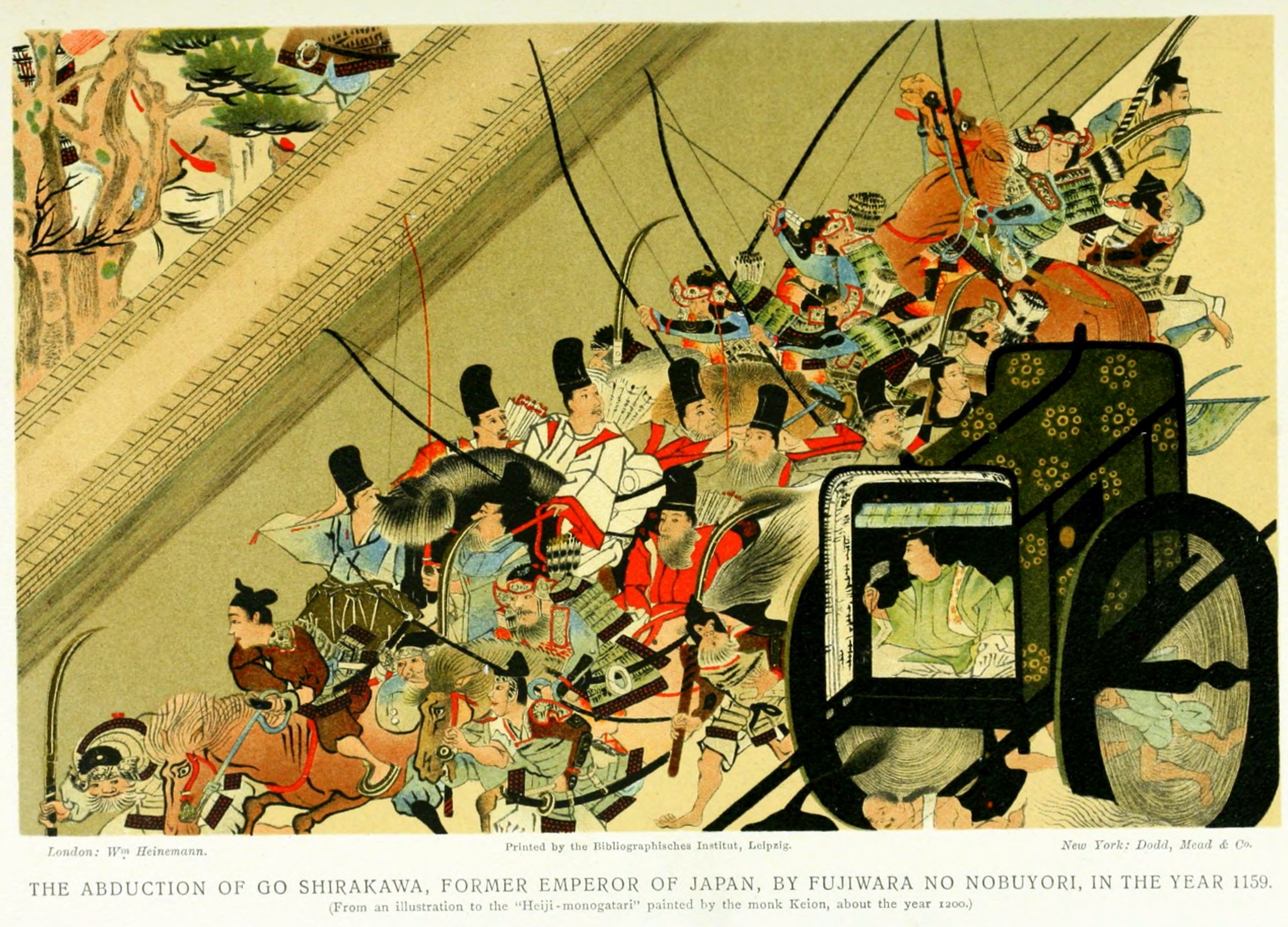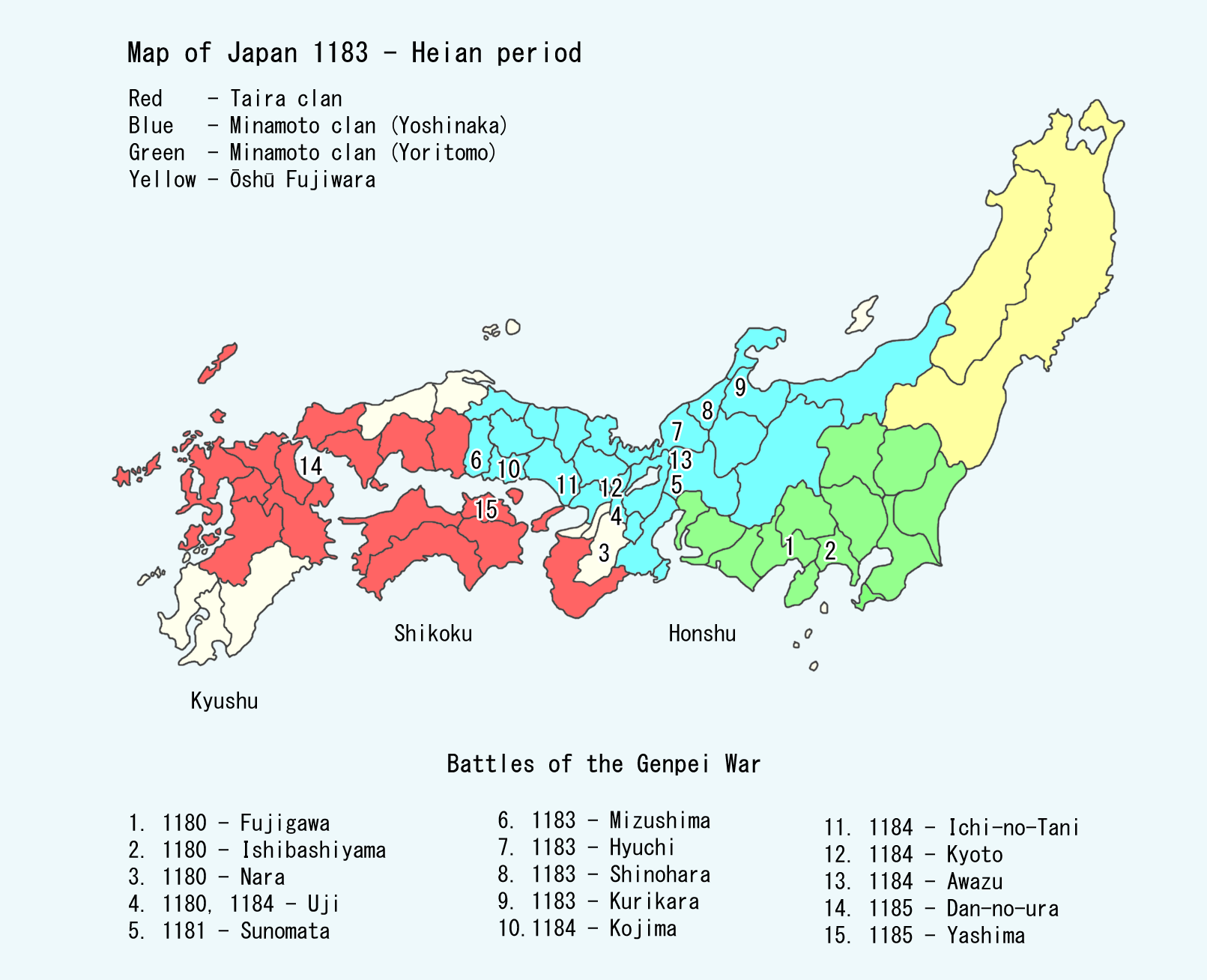|
Hōjō Masako
was a Japanese politician who exercised significant power in the early years of the Kamakura period, which was reflected by her contemporary sobriquet of the "nun shogun". She was the wife of Minamoto no Yoritomo, and mother of Minamoto no Yoriie and Minamoto no Sanetomo, the first, second and third Shogun, shoguns of the Kamakura shogunate, respectively. She was the eldest daughter of Hōjō Tokimasa and sister of Hōjō Yoshitoki, both of them ''shikken'' of the Kamakura shogunate. Early life and marriage (1157–1182) Hōjō Masako (her real name is unknown; she was called Masako after her father's name Tokimasa by later researchers) was born in 1157, eldest child of Hōjō Tokimasa, leader of the influential Hōjō clan of Izu Province, Izu province, and his wife, Hōjō no Maki. Masako's parents were still in their teens, so she was raised by many ladies-in-waiting and nannies. Masako was born into a world of war and strife. In Kyoto, the capital of Japan, the Hōgen Rebel ... [...More Info...] [...Related Items...] OR: [Wikipedia] [Google] [Baidu] |
Midaidokoro
The ''midaidokoro'' (御台所) was the official wife of the ''shōgun''. During the Edo period, she resided in the ''Ōoku'' of Edo Castle and sometimes wielded considerable political power behind the scenes. Heian period * Miyoshi Takako, wife of Sakanoue no Tamuramaro and daughter of Miyoshi Kiyotsugu Kamakura period * Hōjō Masako, daughter of Hōjō Tokimasa, wife of Minamoto no Yoritomo and mother of Minamoto no Yoriie and Minamoto no Sanetomo * Wakasa no Tsubone (d.1203), daughter of Hiki Yoshikazu and wife of Minamoto no Yoriie also mother of Take no Gosho (wife of Kujo Yoritsune) * Bomon Nobuko (1193-1274), daughter of Bomon Nobukiyo and wife of Minamoto no Sanetomo * Minamoto no Yoshiko or Take no Gosho (1202–1234), daughter of second ''shōgun'' Minamoto no Yoriie with Wakasa no Tsubone and wife of Kujo Yoritsune * Hiwadahime (1230–1247), daughter of Hojo Tokiuji and wife of Kujo Yoritsugu * Konoe Saiko (b. 1241), daughter of Konoe Kanetsune, wife of Prince ... [...More Info...] [...Related Items...] OR: [Wikipedia] [Google] [Baidu] |
Hōjō Clan
The was a Japanese samurai family who controlled the hereditary title of '' shikken'' (regent) of the Kamakura shogunate between 1203 and 1333. Despite the title, in practice the family wielded actual political power in Japan during this period compared to both the Kamakura shoguns, or the Imperial Court in Kyoto, whose authority was largely symbolic. The Hōjō are known for fostering Zen Buddhism and for leading the successful opposition to the Mongol invasions of Japan. Resentment at Hōjō rule eventually culminated in the overthrow of the clan and the establishment of the Ashikaga shogunate. History Bloodline The Hōjō are alleged to have been an offshoot of the Taira of the Kanmu branch, originating in Izu Province. On the other hand, modern theories question whether the Hōjō clan was really descended from the Taira clan. They gained power by supporting the defeat of the Taira by supporting the warlord Minamoto no Yoritomo in the Genpei War through both milit ... [...More Info...] [...Related Items...] OR: [Wikipedia] [Google] [Baidu] |
Rokuhara Tandai
was the post of the chiefs of the Kamakura shogunate in imperial capital Kyoto whose agency, the , kept responsibility for security in Kinai and judicial affairs on western Japan, and negotiated with the Imperial Court in Kyoto, imperial court. Despite keeping security, the Rokuhara were also a sort of secret police and widely feared.森幸夫 『六波羅探題の研究』(続群書類従完成会、2005年4月) Rokuhara Tandai was set up after the Jōkyū War, Jōkyū Incident in 1221. The two chiefs were called and , respectively. Kitakata was higher-ranking than Minamikata. Like ''shikken'' and ''rensho'', both posts were monopolized by the powerful Hōjō clan. The agency was destroyed with the Siege of Kamakura (1333), fall of Kamakura shogunate in 1333. List of Rokuhara Tandai Kitakata #Hōjō Yasutoki (r. 1221–1224) #Hōjō Tokiuji (r. 1224–1230) #Hōjō Shigetoki (born 1198), Hōjō Shigetoki (r. 1230–1247) #Hōjō Nagatoki (r. 1247–1256) #Hōjō Tokimochi ... [...More Info...] [...Related Items...] OR: [Wikipedia] [Google] [Baidu] |
Minamoto No Yoshitomo
(1123 – 11 February 1160) was the head of the Minamoto clan and a general of the late Heian period of Japanese history. His son Minamoto no Yoritomo became ''shōgun'' and founded the Kamakura shogunate, the first shogunate in the history of Japan. His Dharma name was Shōjō Juin (勝定寿院). Hōgen Rebellion With the outbreak of the Hōgen Rebellion in 1156, the members of the Minamoto and Taira samurai clans were called into the conflict. Yoshitomo and Taira no Kiyomori both threw their support behind Emperor Go-Shirakawa and Fujiwara no Tadamichi, while Yoshitomo's father, Minamoto no Tameyoshi, sided with the retired Emperor Sutoku and Fujiwara no Yorinaga. Yoshitomo, defeating his father and the forces of Sutoku and Yorinaga, became head of the Minamoto clan and established himself as the main political power in the capital of Kyoto. However, despite attempts to have his father pardoned, Tameyoshi was executed. In the aftermath of the rebellion, the Taira a ... [...More Info...] [...Related Items...] OR: [Wikipedia] [Google] [Baidu] |
Emperor Go-Shirakawa
was the 77th emperor of Japan, according to the traditional order of succession. His de jure reign spanned the years from 1155 through 1158, though arguably he effectively maintained imperial power for almost thirty-seven years through the ''insei'' system – scholars differ as to whether his rule can be truly considered part of the ''insei'' system, given that the Hōgen Rebellion undermined the imperial position. However, it is broadly acknowledged that by politically outmaneuvering his opponents, he attained greater influence and power than the diminished authority of the emperor's position during this period would otherwise allow. Posthumously, this 12th-century sovereign was named after the 11th-century Emperor Shirakawa. ''Go-'' (後), translates literally as "later"; and thus, he is sometimes called the "Later Emperor Shirakawa", or in some older sources, may be identified as "Shirakawa, the second" or as "Shirakawa II". Unusually, the years of Go-Shirakawa's reign ar ... [...More Info...] [...Related Items...] OR: [Wikipedia] [Google] [Baidu] |
Minamoto
was a noble surname bestowed by the Emperors of Japan upon members of the imperial family who were excluded from the line of succession and demoted into the ranks of the nobility since 814."...the Minamoto (1192-1333)". ''Warrior Rule in Japan'', page 11. Cambridge University Press. Several noble lines were bestowed the surname, the most notable of which was the Seiwa Genji, whose descendants established the Kamakura and Ashikaga shogunates following the Heian era. The Minamoto was one of the four great clans that dominated Japanese politics during the Heian period in Japanese history—the other three were the Fujiwara, the Taira, and the Tachibana. In the late Heian period, Minamoto rivalry with the Taira culminated in the Genpei War (1180–1185 AD). The Minamoto emerged victorious and established Japan's first shogunate in Kamakura under Minamoto no Yoritomo, who appointed himself as ''shōgun'' in 1192, ushering in the Kamakura period (1192–1333 AD) of Japanes ... [...More Info...] [...Related Items...] OR: [Wikipedia] [Google] [Baidu] |
Taira No Kiyomori
was a military leader and '' kugyō'' of the late Heian period of Japan. He established the first samurai-dominated administrative government in the history of Japan. Early life Kiyomori was born in Japan, in 1118 as the first son of Taira no Tadamori. His mother, Gion no Nyogo, was wife of Tadamori and a palace servant according to '' The Tale of the Heike''. Family Father: Taira no TadamoriMother: Gion no Nyogo (d. 1147)Concubine(s): Taira no TokikoChildren: * Taira no Shigemori * Taira no Munemori * Taira no Tomomori * Taira no Tokuko * Taira no Shigehira Career After the death of his father in 1153, Kiyomori assumed control of the Taira clan and ambitiously entered the political realm, in which he had previously only held a minor post. Before that though, in 1156, he and Minamoto no Yoshitomo, head of the Minamoto clan, suppressed the rebels in the Hōgen Rebellion. This established the Taira and Minamoto as the top samurai clans in Kyoto. However, this ca ... [...More Info...] [...Related Items...] OR: [Wikipedia] [Google] [Baidu] |
Emperor Of Japan
The emperor of Japan is the hereditary monarch and head of state of Japan. The emperor is defined by the Constitution of Japan as the symbol of the Japanese state and the unity of the Japanese people, his position deriving from "the will of the people with whom resides sovereign power". The Imperial Household Law governs the line of Succession to the Japanese throne, imperial succession. Pursuant to his constitutional role as a national symbol, and in accordance with rulings by the Supreme Court of Japan, the emperor is personally sovereign immunity, immune from prosecution. By virtue of his position as the head of the Imperial House of Japan, Imperial House, the emperor is also recognized as the head of the Shinto religion, which holds him to be the direct descendant of the sun goddess Amaterasu. According to tradition, the office of emperor was created in the 7th century BC, but the first historically verifiable emperors appear around the 5th or 6th centuries Anno Domini, AD ... [...More Info...] [...Related Items...] OR: [Wikipedia] [Google] [Baidu] |
Taira
The was one of the four most important clans that dominated Japanese politics during the Heian period of Japanese history – the others being the Minamoto, the Fujiwara, and the Tachibana. The clan is divided into four major groups, named after the emperors they descended from: Kanmu Heishi, Ninmyō Heishi, Montoku Heishi, and Kōkō Heishi, the most influential of which was the Kanmu Heishi line. In the twilight of the Heian period, the Taira controlled the boy emperor Antoku (himself the grandson of the powerful ''Kugyō'' Taira no Kiyomori) and had effectively dominated the Imperial capital of Heian. However, they were opposed by their rivals the Minamoto clan (the Genji), which culminated in the Genpei War (1180–1185 AD). The five-year-long war concluded with a decisive Taira defeat in the naval Battle of Dan-no-Ura, which resulted in the deaths of Antoku and Taira leaders. Following the war, the victorious Minamoto established Japan's first shogunate in Kamaku ... [...More Info...] [...Related Items...] OR: [Wikipedia] [Google] [Baidu] |
Emperor Sutoku
was the 75th emperor of Japan,Imperial Household Agency (''Kunaichō'') 崇徳天皇 (75)/ref> according to the traditional order of succession. Sutoku's reign spanned the years from 1123 through 1142. Genealogy Before his ascension to the Chrysanthemum Throne, his personal name (his ''imina'') was Akihito (顕仁). Sutoku was the eldest son of Emperor Toba. Some old texts say he was instead the son of Toba's grandfather, Emperor Shirakawa. *Chūgū: Fujiwara no Kiyoko (藤原 聖子) later Kōkamon'in (皇嘉門院), Fujiwara no Tadamichi's daughter * Hyounosuke-no-Tsubone (兵衛佐局), Minamoto no Masamune's adopted daughter ** First son: Imperial (1140–1162). * Mikawa-dono (三河), Minamoto no Morotsune's daughter ** Fifth Son: Kakue (覚恵; 1151–1184) * Karasuma-no-Tsubone (烏丸局) Events of Sutoku's life * February 25, 1123 ('' Hōan 4, 28th day of the 1st month''): In the 16th year of Emperor Toba's reign (鳥羽天皇二十五年), he abdicated; and the s ... [...More Info...] [...Related Items...] OR: [Wikipedia] [Google] [Baidu] |
Emperor Toba
was the 74th Emperor of Japan,Imperial Household Agency (''Kunaichō'') 鳥羽天皇 (74)/ref> according to the traditional order of succession. Toba's reign spanned the years from 1107 through 1123. Genealogy Before his ascension to the Chrysanthemum Throne, his personal name (his ''imina'') was Munehito''-shinnō'' (宗仁親王). He was the son of Emperor Horikawa. His mother was Empress Dowager Fujiwara no Ishi (藤原苡子) Toba had three Empresses, some consort ladies and 14 imperial sons and daughters.Brown, p. 321. * ''chūgū'' : Fujiwara no Tamako (藤原璋子) later Taikenmon’in (待賢門院), Fujiwara no Kinzane‘s daughter ** First Son: Imperial Prince Akihito (顕仁親王) later Emperor Sutoku ** First Daughter: Imperial Princess ''Yoshiko/Kishi'' (禧子内親王; 1122–1133) – Saiin at Kamo Shrine ** Second Son: Imperial Prince Michihito (通仁親王; 1124–1129) ** Third Son: Imperial Prince Kimihito (君仁親王; 1125–1143) ** Second D ... [...More Info...] [...Related Items...] OR: [Wikipedia] [Google] [Baidu] |



